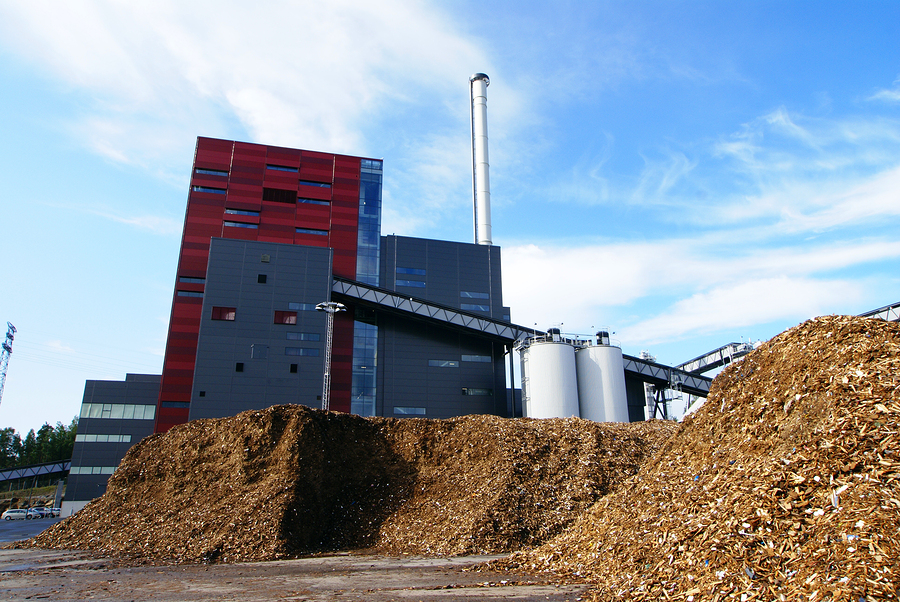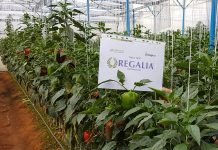David Appleyard
IRENA, the International Renewable Energy Agency, has published a study on the costs of biomass power generation, concluding that the most competitive projects can generate electricity at a cost as low as US$0.06/kWh.
 |
| Bio Power Plant With Storage Of Wooden Fuel photo via BigStock |
Around the world, large quantities of agricultural and forestry wastes go underutilised and the agency argues that using these wastes as a feedstock to provide power and heat can cost less than electricity from the grid.
According to the study, the total installed cost of biomass power generation technologies varies significantly by technology and country. For example, the total installed costs of stoker boilers were between US$1880 and $4260/kW in 2010, while those of circulating fluidised bed boilers were between $2170 and $4500/kW and anaerobic digester systems of between $2570 and $6100/kW.
Operations and maintenance (O&M) costs can make a significant contribution to the levelised cost of electricity (LCOE) and typically account for between 9% and 20% of the LCOE for biomass power plants, the study finds. However, they can account for a lesser percentage than this in the case of co-firing and greater for plants with extensive fuel preparation, handling and conversion needs. Meanwhile, fixed O&M costs range from 2% of installed costs per year to 7% for most biomass technologies, with variable O&M costs of around $0.005/kWh. Landfill gas systems have much higher fixed O&M costs, which can be between 10% and 20% of initial capital costs per year.
A key finding is that secure, long-term supplies of low-cost, sustainably-sourced feedstocks are critical to the economics of biomass power plants. Feedstock costs can be zero for wastes which would otherwise have disposal costs or that are produced onsite at an industrial installation, for example, black liquor at pulp and paper mills or bagasse at sugar mills. Feedstock costs may be modest where agricultural residues can be collected and transported over short distances.
However, citing the trade in wood chips and pellets, the authors note that feedstock costs can be high where significant transport distances are involved due to the low energy density of biomass. The IRENA analysis covers feedstock costs of between $10/tonne for low cost residues to $160/tonne for internationally-traded pellets.
Reducing Costs
Potential for cost reductions in biomass power generation equipment is complicated by the range of technologies available, from the mature to those still at the pilot or R&D stage, and by the often significant variations in local technology solutions, the IRENA analysis states.
Many biomass generation technologies are mature and are not likely to undergo significant technological change, while cost reductions through scale-up will be modest. However, for the less mature technologies, significant cost reductions are likely as commercial experience is gained.
Gasification technologies using wood or waste wood as feedstock may achieve capital cost reductions of 22% by 2020, while those for stoker/BFB/CFB direct combustion technologies will be more modest at between 12% and 16%. By 2015 cost reductions for BFB and CFB gasification technologies could be in the order of 5% to 11%, while for direct combustion cost reductions they may be 0% to 5%. anaerobic digester (AD) technologies could benefit from greater commercialisation, and cost cuts of 17% to 19% might be possible by 2020, with cost reductions of 5% to 8% by 2015.
However, the authors conclude that combustion technologies are well-established and are generally bankable if the project economics are solid. Gasification with low gas energy content and internal combustion engines are an established niche technology in India, but shifting from these simple gasifiers to ones with greater efficiency, using oxygen as a reactive agent, gas clean-up and gas turbines to scale-up this technology to larger power plants still requires more demonstration, especially because it requires expensive gas clean-up, which is currently the main focus of gasification technology improvements. In AD systems, the main technological development needed is linked to the digesters (as better control of the process: enzymes, pH, temperature) and pre-combustion gas clean-up.
According to IRENA, the main question regarding the viability of biomass power plants lies in the development of a reliable feedstock supply chain, especially because long-term feedstock agreements are essential for financing any biomass project. Predicting biomass cost reduction potentials is challenging because many factors are involved, such as the supply chain, resource potential, sustainability criteria and so forth.
Research into cost saving processes is currently underway. For example, it has been shown that denser fuel pellets can offer LCOE savings, but the drawback is that often the pelletisation process results in significant feedstock loss and increased cost. At the same time, the storage and transportation costs of denser pellets are significantly lower than other options, such as baling. Efforts to integrate biomass with traditional agriculture, for example through the use of crop rotation and agricultural intensification, may lead to yield increases and price reductions, the report continues. Sustainable harvesting techniques, such as one-pass harvesting, can reduce harvest site fuel consumption significantly. Further, developing synergies between harvest and transport, for example by using self-compacting wagons for both harvesting and transportation, may also provide cost savings, they add.
Analysis of the potential for biomass feedstock cost reductions for the European market to 2020 suggests that cost reductions of 2% to 25% could be achieved, although average cost reductions for energy crops by 2015 are difficult to estimate. It is assumed that dedicated energy crops will be 5%-10% cheaper as the result of harvesting and logistic improvements by 2015. Trends for forestry and agricultural residue prices and costs are more uncertain due to the complex balance of positive and negative effects.
Competitive Impact
The economics of biomass power generation are critically dependent upon the availability of a secure, long-term supply of feedstock at a competitive cost.
Observing that feedstock costs can represent 40% to 50% of the total cost of electricity produced, the authors note that the lowest cost feedstock is typically agricultural residues. For forestry, the cost is dominated by the collection and transportation costs. The low energy density of biomass feedstocks tends to limit the economical transport distance from a biomass power plant. This can place a limit on the scale of the plant, meaning that biomass struggles to take advantage of economies of scale.
The prices of pellets and woodchips are quoted regularly in Europe by ENDEX and PIX for delivery to Rotterdam or North/Baltic Sea ports and do not include inland transport to other areas.
Prices for biomass sourced and consumed locally are difficult to obtain. Prices paid will depend on the energy content of the fuel, its moisture content and other properties that will impact the costs of handling o
r processing, the document notes.
Dedicated energy crop availability is strongly related to cost, representing the important impact that the best crop, land and climate conditions can have on feedstock costs.
Other important cost considerations for biomass feedstocks include the preparation the biomass requires before it can be used. Analysis suggests that there are significant economies of scale in biomass feedstock preparation and handling. The capital costs for preparation and handling can represent around 6% to 20% of total investment costs. Assuming a heat value of forest residue with 35% moisture content to be 11500 kJ/kg, the handling capital costs could therefore range from a low of $772/GJ/day to as high as $2522/GJ/day.
In Europe, the analysis identified feedstock costs of between $5.2 and $8.2/GJ for European sourced woodchips. Local agricultural residues were estimated to cost $4.8 to $6.0/GJ. Imported pellets from North America are competitive with European wood chips if they must be transported from Scandinavia.
Prices for feedstocks in developing countries are available but relatively limited, the report notes. In the case of Brazil, the price of bagasse varies significantly, depending on the harvest period. It can range from zero to $27/tonne with the average price being around $11/tonne, where a market exists.
In India, the price for bagasse is around $12 to $14/tonne, and the price of rice husks is around $22/tonne. Multiple biomass resources are available, as rice straw, rice husks, bagasse, wood waste, wood, wild bushes and paper mill waste.
Levelised Costs
The range of biomass-fired power generation technologies and feedstock costs result in a large range for the LCOE of biomass-fired power generation. Even for individual technologies, the range can be wide as different configurations, feedstocks, fuel handling and, in the case of gasification, gas clean-up requirements can lead to very different installed costs and efficiencies for a technology.
Assuming a cost of capital of 10%, the LCOE of biomass-fired electricity generation ranges from a low of $0.06/kWh to a high of $0.29/kWh, IRENA states.
Where capital costs are low and low-cost feedstocks are available, bioenergy can provide competitively priced, dispatchable electricity generation. However, with higher capital costs and more expensive fuel costs, power generation from bioenergy is not likely to be able to compete with incumbent technologies without support policies in place. Many of the low-cost opportunities to develop bioenergy-fired power plants will therefore be in taking advantage of forestry or agricultural residues and wastes where low-cost feedstocks and sometimes handling facilities are available. The development of competitive supply chains for feedstocks is therefore very important in making bioenergy generation competitive.
When low-cost stoker boilers are available and fuel costs are low stoker boilers producing steam to power a steam turbine offer competitive electricity at as low as $0.062/kWh. However, where capital costs are high and only imported pellets are available to fire the boiler, the LCOE can be as high as $0.21/kWh.
Combustion in BFB and CFB boilers has a slightly higher LCOE range than stoker boilers due to their higher capital costs.
The LCOE range for gasifiers is very wide, in part due to the range of feedstock costs, but also due to the fact that fixed bed gasifiers are a more proven technology that is cheaper than CFB or BFB gasifiers.
The LCOE for gasifiers ranges from $0.065/kWh for a fixed bed gasifier with low-cost bioenergy fuel to $0.24/kWh for a small-scale gasifier with an internal combustion engine would be suitable for off-grid applications or mini-grids. However, although this is expensive compared to grid-scale options, it is more competitive than a diesel-fired solution.
CHP systems are substantially more expensive but they have higher overall efficiencies, and the sale of heat produced can make CHP very attractive, particularly in the agricultural, forestry and pulp and paper industries; where low-cost feedstocks and process heat needs are located together. The LCOE of stoker CHP systems ranges from $0.072 to $0.29/kWh, including the impact of the credit for heat production. Gasifier CHP systems have a higher but narrower range from $0.12 to $0.28/kWh due to their higher capital costs.
Landfill gas, anaerobic digesters and co-firing have narrower cost ranges. For landfill gas, this is due to the narrow capital cost range and the fact that this also determines the fuel cost. For anaerobic digestion, the capital cost range is relatively narrow, but the feedstock can vary from free for manure or sewage up to $40/tonne for energy crops for digestion. For co-firing, the incremental LCOE cost is as low $0.044 and $0.13/kWh.
Cost of Biomass
According to the IRENA analysis, the LCOE of biomass-fired power plants ranges from $0.06 to $0.29/kWh, depending on capital and feedstock costs. Where low-cost feedstocks – such as agricultural or forestry residues and wastes – are available and capital costs are modest, biomass can be a very competitive power generation option.
Even where feedstocks are more expensive, the LCOE range for biomass is still more competitive than for diesel-fired generation, making biomass an ideal solution for off-grid or mini-grid electricity supply, the report concludes.
The document adds that many biomass power generation options are mature, commercially-available technologies, for example direct combustion, co-firing, anaerobic digestion and municipal solid waste incineration. While others, such as atmospheric biomass gasification and pyrolysis, are less mature and only at the beginning of their deployment, still others are only at the demonstration or R&D phases, for instance integrated gasification combined cycle, bio-refineries and bio-hydrogen.
The potential for cost reductions is therefore very heterogeneous. Only marginal cost reductions are anticipated in the short term, but the long-term potential from the technologies not yet widely deployed is good.
David Appleyard is Chief Editor of Renewable Energy World. He also currently holds the position of Chief Editor for sister publication Hydro Review Worldwide. A journalist and photographer, he graduated with a degree in Applied Environmental Science.








